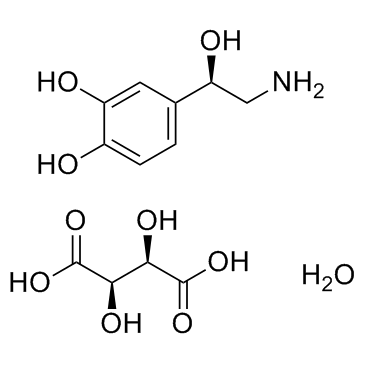Norepinephrine Bitartrate

Norepinephrine Bitartrate structure
|
Common Name | Norepinephrine Bitartrate | ||
|---|---|---|---|---|
| CAS Number | 108341-18-0 | Molecular Weight | 337.28 | |
| Density | N/A | Boiling Point | 442.6ºC at 760mmHg | |
| Molecular Formula | C12H19NO10 | Melting Point | 100-104ºC(lit.) | |
| MSDS | Chinese USA | Flash Point | 221.5ºC | |
| Symbol |

GHS06 |
Signal Word | Danger | |
Use of Norepinephrine BitartrateNorepinephrine bitartrate monohydrate is a β1-selective adrenergic receptor agonist with EC50 of 5.37 μM. |
| Name | l-noradrenaline bitartrate |
|---|---|
| Synonym | More Synonyms |
| Description | Norepinephrine bitartrate monohydrate is a β1-selective adrenergic receptor agonist with EC50 of 5.37 μM. |
|---|---|
| Related Catalog | |
| Target |
EC50: 5.37 μM (β1-selective adrenergic receptor)[1] |
| In Vitro | Norepinephrine(NE) bitartrate monohydrate is generally considered to be a β1-subtype selective adrenergic agonist. Norepinephrine(NE) also has direct activity at the β2-adrenoceptor in higher concentrations[1]. Adipocytes from the inguinal fat pad (iWA) or the interscapular fat pad (BA) are isolated from neonatal wild-type C57BL/6J mice and cultured. To examine the effect of activating AT2 upon β-adrenergic signaling, cAMP production is first assessed in response to Norepinephrine (NE, 10 µM) with or without CGP (10 nM) co-treatment. Norepinephrine (NE) increases cAMP as expected in iWA, and CGP does not alter this effect. Norepinephrine (NE) is also known to induce lipolysis, and liberated fatty acids are required to functionally activate UCP1 protein and to stimulate heat production. CREB phosphorylation at Ser133 is increased after Norepinephrine (NE) treatment and significantly attenuated with CGP co-treatment in mouse iWA[2]. |
| Cell Assay | Subcutaneous preadipocytes derived from a 38-year old non-diabetic female donor are immortalized with TERT and HPV E6/E7. For the current studies, a stable diploid clone (referred to as clone B) with consistent differentiation capacity is isolated by ring cloning. Cells are grown in preadipocyte PGM2 media. Once cells are confluent, differentiation is induced by incubation in differentiation media consisting of dexamethasone, IBMX, indomethacin, and additional insulin. Cells are differentiated for 10 days. Prior to treatment, media is replaced with PGM2 media for one day and then switched to serum-free media overnight for treatments. Adipocytes are treated for 6 hours with vehicle, Norepinephrine (NE, 10 μM), CGP (10 nM), or Norepinephrine (NE) and CGP[2]. |
| References |
| Boiling Point | 442.6ºC at 760mmHg |
|---|---|
| Melting Point | 100-104ºC(lit.) |
| Molecular Formula | C12H19NO10 |
| Molecular Weight | 337.28 |
| Flash Point | 221.5ºC |
| PSA | 201.77000 |
| Vapour Pressure | 1.3E-08mmHg at 25°C |
| Index of Refraction | -11 ° (C=5, H2O) |
| Storage condition | Refrigerator |
| Water Solubility | H2O: soluble50mg/mL, clear |
| Symbol |

GHS06 |
|---|---|
| Signal Word | Danger |
| Hazard Statements | H300 + H310 + H330 |
| Precautionary Statements | Missing Phrase - N15.00950417-P260-P262-P280-P302 + P352 + P310-P304 + P340 + P310 |
| Personal Protective Equipment | Eyeshields;Faceshields;full-face particle respirator type N100 (US);Gloves;respirator cartridge type N100 (US);type P1 (EN143) respirator filter;type P3 (EN 143) respirator cartridges |
| Hazard Codes | T+: Very toxic; |
| Risk Phrases | R26/27/28 |
| Safety Phrases | 22-26-36/37/39-45-36/37-28 |
| RIDADR | UN 2811 |
| WGK Germany | 3 |
| RTECS | DN6750000 |
| Packaging Group | III |
| HS Code | 2922210000 |
| HS Code | 2922509090 |
|---|---|
| Summary | 2922509090. other amino-alcohol-phenols, amino-acid-phenols and other amino-compounds with oxygen function. VAT:17.0%. Tax rebate rate:13.0%. . MFN tariff:6.5%. General tariff:30.0% |
|
6-hydroxydopamine-mediated release of norepinephrine increases faecal excretion of Salmonella enterica serovar Typhimurium in pigs.
Vet. Pathol. 41 , 68, (2010) Salmonella enterica serovar Typhimurium is an animal and zoonotic pathogen of worldwide importance. In pigs, transport and social stress are associated with reactivation and spread of Salmonella Typhi... |
|
|
Skin blood flow and local temperature independently modify sweat rate during passive heat stress in humans.
J. Appl. Physiol. 109 , 1301-6, (2010) Sweat rate (SR) is reduced in locally cooled skin, which may result from decreased temperature and/or parallel reductions in skin blood flow. The purpose of this study was to test the hypotheses that ... |
| Norepinephrine Bitartrate |
| L-Arterenol Bitartrate Monohydrate |
| (2R,3R)-2,3-Dihydroxysuccinic acid - 4-[(1R)-2-amino-1-hydroxyethyl]-1,2-benzenediol (1:1) |
| MFCD00150449 |
| 4-(2-Amino-1-hydroxyethyl)benzene-1,2-diol 2,3-dihydroxysuccinate (1:1) |
| Butanedioic acid, 2,3-dihydroxy-, (2R,3R)-, compd. with 4-[(1R)-2-amino-1-hydroxyethyl]-1,2-benzenediol (1:1) |
| L-(-)-Norepinephrine (+)-bitartrate salt monohydrate |
| 4-(2-Amino-1-hydroxyethyl)-1,2-benzenediol 2,3-dihydroxysuccinate (1:1) |
| L-Norepinephrine Bitartrate Monohydrate |
| Noradrenaline bitartrate monohydrate |
| 1,2-Benzenediol, 4-(2-amino-1-hydroxyethyl)-, 2,3-dihydroxybutanedioate (1:1) (salt) |
| L-Norepinephrine Hydrogen L-Tartrate Monohydrate |
| 4-(2-amino-1-hydroxyethyl)benzene-1,2-diol 2,3-dihydroxybutanedioate (1:1) |
| L-Noradrenaline Bitartrate Monohydrate |
| Norepinephrine (bitartrate monohydrate) |

